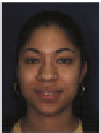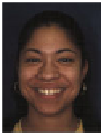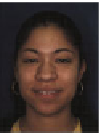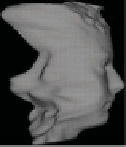Graphics Reference
In-Depth Information
5.5.1 The BU-4DFE Database
The 3D and 4D databases used for facial expression recognition have been summarized in
Section 5.2 and further details on can be found in Yin et al. (2008). To make the discussion
simpler, we recall, in the following sections, the main features of the dynamic 3D facial
expression database that recently created at Binghamton University (Yin et al., 2008).
The 3D scans have been constructed by capturing a sequence of stereo images of subjects
exhibiting facial expressions and producing a depth map for each frame. The range maps are
then combined to produce a temporally varying sequence of 3D scan. Subjects were requested
to perform the six prototypic expressions, separately, in such a way that each expression
sequence contained neutral expressions in the beginning and at the end. In particular, each
expression was performed gradually from neutral appearance, low intensity, high intensity,
and back to low intensity and neutral. Each 3D sequence captures one expression at a rate of
25 frames per second and each 3D sequence lasts approximately 4 seconds with about 35,000
vertices per scan (i.e., 3D
frame
). The database consists of 101 subjects including 606 3D
model sequences with six prototypic expressions. Examples of 2D and 3D frames sampled
from the
happy
4D sequences of subject F021 are given in Figure 5.18.
An example of a 3D dynamic facial sequence of a subject with the
happy
expression is
showninFigure5.18
a
, where 2D frames (not used in our solution) and 3D frames before
preprocessing are reported. For each row, five frames are given (out of the 98 total frames of
the specific sequence) each representing a sample of the start and end of the sequence (first
and last frame), of the intensity of the facial expression in the
onset
and
offset
intervals of the
sequence, and of the interval of the sequence with the larger intensity of the expression (
apex
).
From a preliminary analysis, we note that the resolution of the individual scans of 3D
sequences is not very high. In fact, the average number of vertices per scan is reasonable
2D
frames
frontal
3D
frames
side
#47 apex
#97 neutral
#0 neutral
#18 onset
#82 offset
(a)
(b)
Figure 5.18
BU-4DFE: (a) Frames from the dynamic sequence of subject F021 (happy expression).
For each row, five frames are reported out of 98 total frames of the sequence; (b) a raw 3D frame before
preprocessing is shown from frontal and side view












